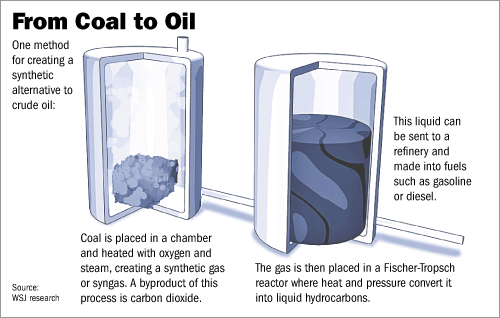History of Synthetic Fuel
by Rudy P. SysAdmin at howtofindthemoney
Synthetic fuel or synfuel is a liquid fuel, or sometimes gaseous fuel, obtained from syngas, a mixture of carbon monoxide and hydrogen, in which the syngas was derived from gasification of solid feedstock’s such as coal or biomass or by reforming of natural gas.
Common methods for manufacturing synthetic fuels include the Fischer Tropsch conversion, methanol to gasoline conversion, or direct coal liquefaction.
As of July 2009, worldwide commercial synthetic fuels production capacity was over 240,000 barrels per day (38,000 m3/d), with numerous new projects in construction or development.
The term ‘synthetic fuel’ or ‘synfuel’ has several different meanings and it may include different types of fuels. More traditional definitions, example: definition given by the International Energy Agency, define ‘synthetic fuel’ or synfuel’ as any liquid fuel obtained from coal or natural gas. The Energy Information Administration defines synthetic fuels in its Annual Energy Outlook 2006, as fuels produced from coal, natural gas, or biomass feedstocks through chemical conversion into synthetic crude and/or synthetic liquid products. A number of synthetic fuel’s definitions include fuels produced from biomass, and industrial and municipal waste. The definition of synthetic fuel also allows oil sands and oil shale as synthetic fuel sources, and in addition to liquid fuels, synthesized gaseous fuels are also considered to be synthetic fuels: in his ‘Synthetic fuels handbook’ petro chemist James G. Speight included liquid and gaseous fuels as well as clean solid fuels produced by conversion of coal, oil shale or tar sands, and various forms of biomass, although he admits that in the context of substitutes for petroleum-based fuels it has even wider meaning. Depending on the context, methanol, ethanol and hydrogen may also be included.
Synthetic fuels are produced by the chemical process of conversion. Conversion methods could be direct conversion into liquid transportation fuels, or indirect conversion, in which the source substance is converted initially into syngas which then goes through additional conversion process to become liquid fuels. Basic conversion methods include carbonization and pyrolysis, hydrogenation, and thermal dissolution.
Direct conversion of coal to synthetic fuel was originally developed in Germany. The Bergius process was developed by Friedrich Bergius, yielding a patent in 1913. Karl Goldschmidt invited him to build an industrial plant at his factory the Th. Goldschmidt AG (now known as Evonik Industries) in 1914.Production began in 1919.
Indirect coal conversion (where coal is gasified and then converted to synthetic fuels) was also developed in Germany by Franz Fischer and Hans Tropsch in 1923. During World War II, Germany used
Synthetic oil manufacturing (German: Kohleverflüssigung) to produce substitute (Ersatz) oil products by using the Bergius process (from coal), the Fischer–Tropsch process (water gas), and other methods (Zeitz used the TTH and MTH processes). In 1931, the British Department of Scientific and Industrial Research located in Greenwich, England, set up a small facility where hydrogen gas was combined with coal at extremely high pressures to make a synthetic fuel.
The Bergius process plants were Nazi Germany’s primary source of high-grade aviation gasoline, synthetic oil, synthetic rubber, synthetic methanol, synthetic ammonia, and nitric acid. Nearly one third of the Bergius production was produced by plants in Pölitz (Polish: Police) and Leuna, with 1/3 more in five other plants (Ludwigshafen had a much smaller Bergius plant which improved “gasoline quality by dehydrogenation” using the DHD process).
Sponsor Ads
Created on Jul 25th 2019 02:09. Viewed 794 times.
Comments
No comment, be the first to comment.



